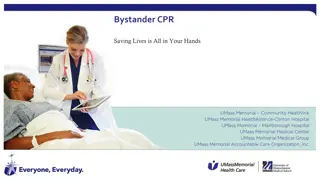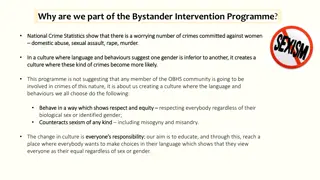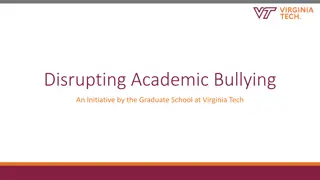Understanding Bystander Intervention in Sensitive Situations
Learn about the role of a bystander in sensitive situations, including types of bystanders and how to intervene effectively. Explore scenarios and factors affecting intervention and non-intervention, emphasizing the importance of noticing, interpreting, feeling responsible, and possessing necessary skills to act.
Download Presentation

Please find below an Image/Link to download the presentation.
The content on the website is provided AS IS for your information and personal use only. It may not be sold, licensed, or shared on other websites without obtaining consent from the author. Download presentation by click this link. If you encounter any issues during the download, it is possible that the publisher has removed the file from their server.
E N D
Presentation Transcript
2 We will learn & work together as a group in this programme. Some of the material is sensitive & some of us will have personal experience of the things we discuss. We will all be respectful of personal emotions as we learn. Confidentiality Appropriate language Attendance Communicating with the facilitator Please be aware that we will be discussing sensitive issues that might have affected you or people you care about. If you feel uncomfortable or upset it is fine to leave the space. Facilitators will understand & are trained to help you.
3 Who is a Bystander? Not involved in the event (not a victim or perpetrator) Witnesses a situation
4 Type of Bystander? Active or prosocial Passive bystander bystander (intervenes) (does nothing)
5 It s a lovely sunny day and you are sitting by the river on your own, no one else is around. Suddenly you hear splashing and screaming for help. A person is caught in the current and drowning. You are the bystander. There is no mobile phone signal. You can swim. There is a life ring on the riverbank. What do you do? [Adapted from Crapser, B. G., & Stewart, A. L. (2014). Men's Project: Sexual assault prevention program for college men program manual. Storrs, CT: University of Connecticut,pp.26-27]
6 A bystander can intervene to stop events before they happen or while they are happening a bystander can PREVENT the potential outcome as well as deal with an outcome.
7 Have you ever been in a situation where you have been a bystander & something problematic has happened? Did you Intervene? (active/prosocial) Not intervene? (passive)
8 What factors are at play in Intervention? Non Intervention?
9 Not laughing at a joke Facebook post Distraction Being supportive to friends Body language signaling disapproval Interruption What is an Intervention? Its not all about confrontation!
10 4 Stages for Intervention 1. Notice the event 2. Interpret it as a problem 3. Feel responsible for dealing with it 4. Possess necessary skills to act [Adapted from Berkowitz, A. (2009) Response Ability: A Complete Guide to Bystander Intervention, Beck & Co., p. 10]
11 Reasons for non-intervention 1. Social influence / identity 2. Audience inhibition 3. Diffusion of responsibility 4. Fear of retaliation 5. Pluralistic ignorance [Adapted from Berkowitz, A. (2009) Response Ability: A Complete Guide to Bystander Intervention, Beck & Co., p.18]
12 Only intervene when it is safe for you to do so. If not safe, in an emergency, dial 999.
13 This programme is specifically about bystander intervention in sexual violence & domestic abuse.
14 Why? Evidence shows that: 77% students have experienced sexual harassment (Cambridge 2014 p.6) 91% of 12% women students subjected to stalking (NUS 2011 p.3) Women aged 16-24 have higher risk of experiencing domestic abuse (ONS 2013) perpetrators of sexual assault were men (Cambridge 2014 p.6) 7% women students experienced a serious sexual assault (NUS 2011 p.3) 28.5% students experienced sexual assault (Cambridge 2014 p.6) 85% experienced a negative impact on their mental health (Cambridge 2014 p.6) References at end of slide show
15 Key Points Domestic abuse, sexual coercion & rape in student populations are a serious and widespread problem. Anyone can experience the trauma of being in an abusive relationship or situation & anyone can be an abuser. However The majority of harm is experienced by women & the majority of people who do the harming are men. But This doesn t mean that most men or all men are offenders or that no women are offenders!
16 How does this make you feel? Research indicates that: Prevention messages can be heard by some as defining all men as perpetrators only and women onlyas victims (Powell 2011)
17 All students (& staff) have the right to live and study in an environment of dignity & respect, free from the fear of harassment or violence. (NUS study: NUS (National Union of Students) (2011) (2nd Ed.) Hidden Marks. London: NUS. Online at: http://www.nus.org.uk/Global/NUS_hidden_marks_report_2nd_edition_web.pdf, Foreword)
VIOLENCE & ABUSE ARE EVERYONE S PROBLEM 18 Impacts on victims, our friends & and loved ones Costs our society an estimated 15.7bn per year (UK) & 2.3bn per year in Scotland (Walby, S. (2009) The Cost of Domestic Violence: Up-date 2009 http://www.caada.org.uk/commissioners/The%20Cost%20of%20Domestic%20Violence%20- %20Walby%202009.pdf)
19 YOU ARE OUR FUTURE LEADERS! STEP UP! SPEAK OUT! BE HEARD! University of the West of England bystander film YouTube: https://youtu.be/SgVQB0SKbFU 2014 White House video YouTube: https://youtu.be/xLdElcv5qqc























